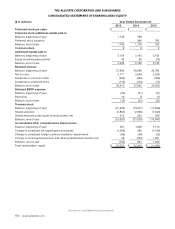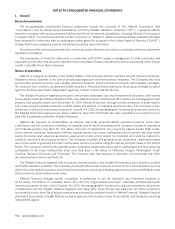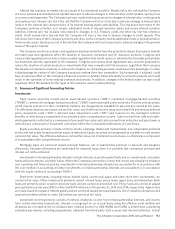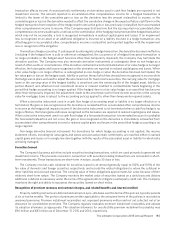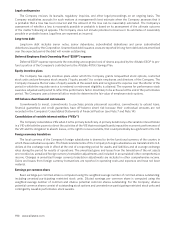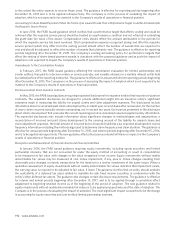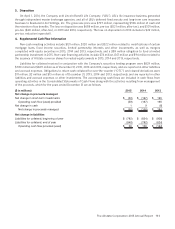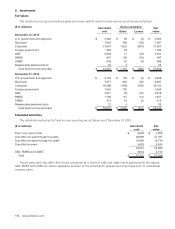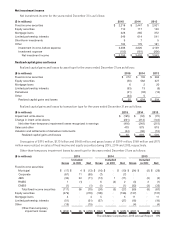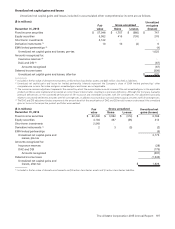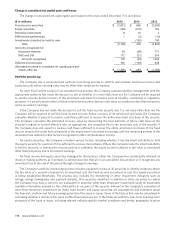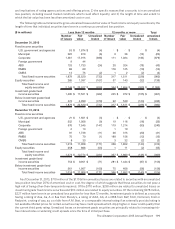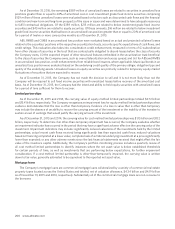Allstate 2015 Annual Report Download - page 196
Download and view the complete annual report
Please find page 196 of the 2015 Allstate annual report below. You can navigate through the pages in the report by either clicking on the pages listed below, or by using the keyword search tool below to find specific information within the annual report.190 www.allstate.com
Legal contingencies
The Company reviews its lawsuits, regulatory inquiries, and other legal proceedings on an ongoing basis. The
Company establishes accruals for such matters at management’s best estimate when the Company assesses that it
is probable that a loss has been incurred and the amount of the loss can be reasonably estimated. The Company’s
assessment of whether a loss is reasonably possible or probable is based on its assessment of the ultimate outcome
of the matter following all appeals. The Company does not include potential recoveries in its estimates of reasonably
possible or probable losses. Legal fees are expensed as incurred.
Long-term debt
Long-term debt includes senior notes, senior debentures, subordinated debentures and junior subordinated
debentures issued by the Corporation. Unamortized debt issuance costs are reported in long-term debt and are amortized
over the expected period the debt will remain outstanding.
Deferred Employee Stock Ownership Plan (“ESOP”) expense
Deferred ESOP expense represents the remaining unrecognized cost of shares acquired by the Allstate ESOP to pre-
fund a portion of the Company’s contribution to the Allstate 401(k) Savings Plan.
Equity incentive plans
The Company has equity incentive plans under which the Company grants nonqualified stock options, restricted
stock units and performance stock awards (“equity awards”) to certain employees and directors of the Company. The
Company measures the fair value of equity awards at the award date and recognizes the expense over the shorter of the
period in which the requisite service is rendered or retirement eligibility is attained. The expense for performance stock
awards is adjusted each period to reflect the performance factor most likely to be achieved at the end of the performance
period. The Company uses a binomial lattice model to determine the fair value of employee stock options.
Off-balance sheet financial instruments
Commitments to invest, commitments to purchase private placement securities, commitments to extend loans,
financial guarantees and credit guarantees have off-balance sheet risk because their contractual amounts are not
recorded in the Company’s Consolidated Statements of Financial Position (see Note 7 and Note 14).
Consolidation of variable interest entities (“VIEs”)
The Company consolidates VIEs when it is the primary beneficiary. A primary beneficiary is the variable interest holder
in a VIE with both the power to direct the activities of the VIE that most significantly impact the economic performance of
the VIE and the obligation to absorb losses, or the right to receive benefits, that could potentially be significant to the VIE.
Foreign currency translation
The local currency of the Company’s foreign subsidiaries is deemed to be the functional currency of the country in
which these subsidiaries operate. The financial statements of the Company’s foreign subsidiaries are translated into U.S.
dollars at the exchange rate in effect at the end of a reporting period for assets and liabilities and at average exchange
rates during the period for results of operations. The unrealized gains and losses from the translation of the net assets
are recorded as unrealized foreign currency translation adjustments and included in accumulated other comprehensive
income. Changes in unrealized foreign currency translation adjustments are included in other comprehensive income.
Gains and losses from foreign currency transactions are reported in operating costs and expenses and have not been
material.
Earnings per common share
Basic earnings per common share is computed using the weighted average number of common shares outstanding,
including unvested participating restricted stock units. Diluted earnings per common share is computed using the
weighted average number of common and dilutive potential common shares outstanding. For the Company, dilutive
potential common shares consist of outstanding stock options and unvested non-participating restricted stock units and
contingently issuable performance stock awards.


